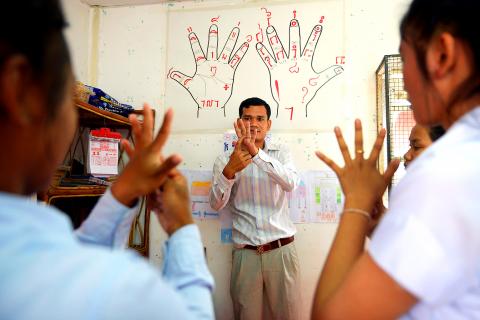At a hairdresser’s shop in the Cambodian capital, there is none of the usual chit chat you might expect when getting a haircut — because the barbers are all deaf.
They have graduated from the only education course for deaf adults in Cambodia, where the vast majority of people with hearing problems never had the opportunity to learn sign language.
“I didn’t have any contact outside of my family. It was like being in prison. I was stuck there. I couldn’t do anything. I didn’t have any money. I didn’t have any education,” barber trainee Oeun Darong, 27, explained in Cambodian sign language.

Photo: AFP
Until the late 1990s, Cambodia was one of the few countries in the world without its own sign language.
But that is changing thanks to the work of American priest Charlie Dittmeier, who began to develop the kingdom’s own version with help from foreign linguists and researchers after he was posted in the Southeast Asian nation 13 years ago.
“We get people coming to us at the age of 25, 30, 35. They have never been to school a day in their life. They have no language,” said Dittmeier.
His Deaf Development Programme (DDP) is one of only two groups running schools for people with hearing problems in Cambodia. The other one is for children.
About 30 deaf students aged 16 or older are currently taking a two-year course at the DDP center in Phnom Penh, learning simple sign language, writing, reading and other life skills, said Dittmeier.
A third year is spent in job training like at the barber shop, where the students receive instructions — given in sign language — on how to offer haircuts, shaves and ear cleaning.
‘I couldn’t talk to my family’
Many have spent their life working in rice fields or as cattle herders, with no one to teach them how to use sign language.
“I was by myself. It was a sad life. I couldn’t learn anything. I couldn’t talk to my family,” said Darong, who once thought he was the only deaf person in the world.
He was born into a family of farmers — one of eight children — and missed out on an education.
“The others would walk to school but I was left at home taking care of the cow, fishing and working in the garden, while they would go and learn how to read and write.”
Other pupils at the same deaf school had even worse experiences, such as the pair rescued from one of the country’s rehabilitation centers, which rights activists criticize for unlawfully detaining street children, beggars, drug users and other undesirables.
“They had no social skills at all. They did not know how to take a shower,” said Dittmeier.
On the walls of the DDP center, some drawings show the basic rules of hygiene, while others teach Cambodian sign language.
“We are constantly trying to expose them to new ideas and then they start developing the signs. Then our work is to record the signs. We draw them. We scan them. We put them into books and dictionaries,” Dittmeier said.
“When they start wanting to talk about new topics they will develop new signs. It shouldn’t come from the hearing people — it should come from the deaf people. And so their life expands, their language expands, their world expands.”
No longer ignored
There are estimated to be more than 50,000 deaf people across Cambodia, yet only a fraction of them have learned sign language.
For those who do, it can be a life-changing step.
“I can now communicate,” said 23-year-old student Kheng Nat. “People don’t ignore me or discriminate against me here. It is not like at home or in the village.”
The situation in Cambodia, which has no state-funded education program for the deaf, is by no means unique.
“Worldwide, deaf children and young people are often denied an education, including in sign language,” said Shantha Rau Barriga, disability rights director at New York-based Human Rights Watch.
“Sign language is critical for deaf people to be able to communicate, express themselves and learn,” she added.
The World Federation of the Deaf (WFD) campaigns for better access to education for the 70 million deaf people around the world, the majority of whom live in developing countries that lack well-trained sign language teachers. In many nations, the quality of education for deaf people is low and the illiteracy rate is high, according to the WFD, which deplores “a massive ignorance in education systems about the importance of sign language.”
One of the first things students do when they enter the DDP school in Phnom Penh is to choose their own sign name — a crucial step towards leaving their solitary life behind.
“I met lots of deaf people here who are now my friends,” said Darong. “I’m not by myself anymore.”

June 2 to June 8 Taiwan’s woodcutters believe that if they see even one speck of red in their cooked rice, no matter how small, an accident is going to happen. Peng Chin-tian (彭錦田) swears that this has proven to be true at every stop during his decades-long career in the logging industry. Along with mining, timber harvesting was once considered the most dangerous profession in Taiwan. Not only were mishaps common during all stages of processing, it was difficult to transport the injured to get medical treatment. Many died during the arduous journey. Peng recounts some of his accidents in

“Why does Taiwan identity decline?”a group of researchers lead by University of Nevada political scientist Austin Wang (王宏恩) asked in a recent paper. After all, it is not difficult to explain the rise in Taiwanese identity after the early 1990s. But no model predicted its decline during the 2016-2018 period, they say. After testing various alternative explanations, Wang et al argue that the fall-off in Taiwanese identity during that period is related to voter hedging based on the performance of the Democratic Progressive Party (DPP). Since the DPP is perceived as the guardian of Taiwan identity, when it performs well,

A short walk beneath the dense Amazon canopy, the forest abruptly opens up. Fallen logs are rotting, the trees grow sparser and the temperature rises in places sunlight hits the ground. This is what 24 years of severe drought looks like in the world’s largest rainforest. But this patch of degraded forest, about the size of a soccer field, is a scientific experiment. Launched in 2000 by Brazilian and British scientists, Esecaflor — short for “Forest Drought Study Project” in Portuguese — set out to simulate a future in which the changing climate could deplete the Amazon of rainfall. It is

The Taiwan People’s Party (TPP) on May 18 held a rally in Taichung to mark the anniversary of President William Lai’s (賴清德) inauguration on May 20. The title of the rally could be loosely translated to “May 18 recall fraudulent goods” (518退貨ㄌㄨㄚˋ!). Unlike in English, where the terms are the same, “recall” (退貨) in this context refers to product recalls due to damaged, defective or fraudulent merchandise, not the political recalls (罷免) currently dominating the headlines. I attended the rally to determine if the impression was correct that the TPP under party Chairman Huang Kuo-Chang (黃國昌) had little of a